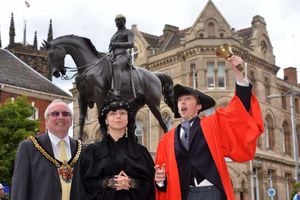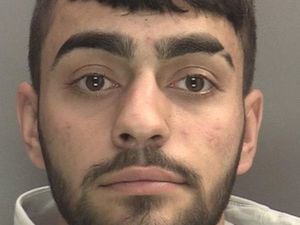Wolverhampton's 'Man on the Oss' Prince Albert statue stars in royal celebration
It's become a city landmark, a meeting place for friends and known fondly by many as the Man on the Oss.

But the unveiling of the Prince Albert statue in 1866 saw Wolverhampton go down in history – by becoming the first place Queen Victoria visited since the death of her beloved consort.
And celebrations ahead of the 150th anniversary of the monarch's visit on November 30 have already begun.
This week schoolchildren and residents has the chance to view a commemorative book and watch a re-enactment of what happened on that momentous day by young performers at Central Youth Theatre.
It was five years after Prince Albert died and the Monarch was still in deep mourning, having previously turned down suggestions of public appearances.
She had rejected requests from Manchester and Liverpool so it was a surprise when she agreed to come in person to Wolverhampton to unveil the memorial statue created in honour of her husband.
Until November 30, 1866, she had not made any visits outside of the capital during her reign and why she accepted their invitation in Wolverhampton remains a bit unclear. One theory is that she been left touched after receiving a letter of sympathy from some Wolverhampton widows and vowed to visit if the opportunity ever arose.
Another explanation is that it was just good timing as the invitation had come along soon after she had been advised to resume her public duties following her consort's death.
After the then Mayor of Wolverhampton, George Lees Underhill, began a subscription to raise funds for the statue, Queen Victoria was consulted on the design.
It was agreed that a statue of him mounted on his favourite horse and dressed in the uniform of a field marshal would be appropriate.
Renowned sculptor Thomas Thorneycroft was chosen to make the statue, which cost £1150 and after years of hard work was completed in 1865.
The Queen's visit on November 30 1866brought the town centre to a standstill and came just nine days after she had accepted the invitation.
The Royal arrived by train with other members of her family and rode in a procession of open carriages through the town to Market Place where the statue was veiled by curtains in the national colours.
A pavilion had been erected to protect the royal party along with a grandstand for 2,000 people. The current Mayor, John Morris, then read a welcome speech to the Queen.
Her Majesty was so impressed with the reception she had been given that she asked the mayor to kneel and borrowing a sword from Lord Alfred Paget, astonished everyone by knighting him Sir John Morris.
She then signalled to the sculptor Mr Thorneycroft who drew a cord to complete the unveiling, and she walked around to inspect the memorial.
After the ceremony the royal party took a different route back to the Great Western Railway where they had lunch before departing for Windsor.
The current Mayor of Wolverhampton Councillor Barry Findlay said the city was right to be proud of the statue and Queen Victoria's visit.
"People have asked me why she came and I told them it because the people of Wolverhampton asked her to. She unveiled the statue -– the Man on the Oss and after her visit that part of the town which was known as High Green was called Queen Square," he said.
He paid tribute to the performers from Central Youth Theatre – Danni-Jay Rhodes-O'Neill , who played Queen Victoria,Zak Douglas,who took on the role of sculptor George Thorneycroft, Ottis Pickard who played John Morris, Adam Halcro who was the town crier and Faye Campbell who was the Queen's assistant – describing them as 'absolutely fantastic' and thanked them for bringing the past to life.
Around 300 schoolchildren are among those who have visited during the week to find out more about the royal visit and view related items from the city's archives and art gallery.
Also visiting the mayor's parlour to view the historic memorabilia was Rosemary Collins, of Castlecroft, Wolverhampton.
She said: "I think it's important because it's part of Wolverhampton's history and it's something everyone should be aware of."
The city council is also busy making plans for a commemorative event which will take place around the anniversary of the visit in November.





